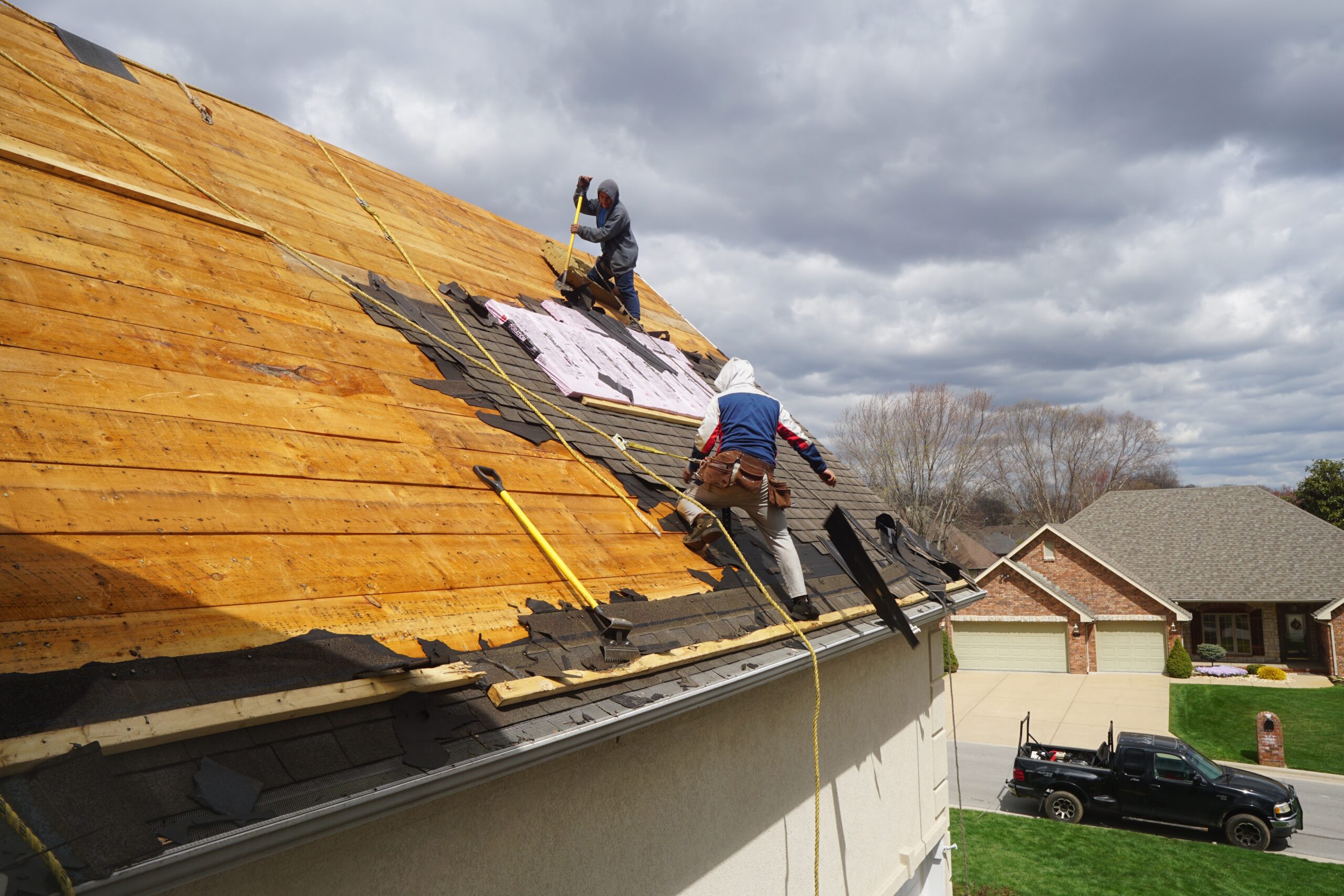Are you prepared for a roofing emergency? Whether it’s a severe storm, a fallen tree, or a sudden leak, having the knowledge to address roofing emergencies quickly and effectively is essential. In this article, we will guide you through everything you need to know in order to handle these unexpected situations with confidence.
With years of experience and expertise in the industry, we understand the urgency and stress that comes with roofing emergencies. That’s why we’re here to empower you with the information you need to make informed decisions and take immediate action.
From identifying common roofing issues to implementing temporary repairs and contacting professional roofers, we’ll cover the essential steps to help you mitigate the damage and restore the safety and integrity of your roof.
Don’t let a roofing emergency catch you off guard. Equip yourself with the necessary knowledge and resources to tackle the situation head-on. Keep reading to discover how you can handle roofing emergencies like a pro.

Understanding Roofing Emergencies
Roofing emergencies can occur at any time and can result in significant damage to your property if not addressed promptly. Understanding the nature of these emergencies is the first step in effectively dealing with them.
A roofing emergency refers to any situation where your roof is compromised and requires immediate attention. This can be caused by various factors such as severe weather conditions, fallen trees, structural issues, or even poor maintenance. The key is to recognize the signs of a roofing emergency and take appropriate action to prevent further damage.
Common Causes of Roofing Emergencies
Roofing emergencies can be caused by a wide range of factors, many of which are beyond our control. By being aware of these common causes, you can better prepare yourself and minimize the impact of such emergencies.
One of the most common causes of roofing emergencies is severe weather conditions. High winds, heavy rain, hailstorms, and snow can all wreak havoc on your roof, leading to leaks, missing shingles, or even structural damage. Additionally, fallen trees or branches can cause significant damage to your roof, especially during storms.
Other causes of roofing emergencies include poor installation or maintenance, age-related wear and tear, and structural issues. It’s important to regularly inspect your roof and address any underlying issues to prevent emergencies from occurring.

Signs of a Roofing Emergency
Recognizing the signs of a roofing emergency is crucial for taking immediate action and preventing further damage. Some common signs include:
1. Water leaks: If you notice water stains on your ceiling or walls, this indicates a leak in your roof. Immediate action is necessary to prevent further water damage to your property.
2. Missing or damaged shingles: Shingles that are cracked, curled, or completely missing can leave your roof vulnerable to leaks and other damage. It’s important to address these issues promptly to maintain the integrity of your roof.
3. Sagging or drooping areas: If you notice any areas of your roof that appear saggy or droopy, this could indicate a structural issue that requires immediate attention. Ignoring these signs can lead to more severe damage or even collapse.
4. Mold or mildew growth: Excessive moisture in your roof can lead to the growth of mold or mildew, which can pose health risks and further deteriorate the condition of your roof. If you notice any signs of mold or mildew, it’s crucial to address the underlying issue as soon as possible.
Immediate Actions to Take During a Roofing Emergency
When faced with a roofing emergency, taking immediate action can help mitigate the damage and ensure the safety of your property. Here are some essential steps to follow:
1. Ensure safety: The first and most important step is to prioritize your safety and the safety of others. If you suspect a structural issue or if the situation is hazardous, evacuate the area and seek professional help if necessary.
2. Document the damage: Before you begin any repairs, it’s essential to document the damage for insurance purposes. Take photos or videos of the affected areas to provide evidence of the emergency and the extent of the damage.
3. Temporarily seal the leak: If you have a leak, it’s important to temporarily seal it to prevent further water damage. Use a tarp or plastic sheeting to cover the affected area and secure it tightly to prevent water from entering your property.
4. Clear debris: If your roof has been damaged by fallen trees or branches, carefully remove any debris that could cause further damage or pose a safety risk. Use caution and seek professional assistance if necessary.
5. Contact your insurance provider: It’s important to notify your insurance provider as soon as possible to initiate the claims process. Provide them with all the necessary documentation and information about the emergency to expedite the process.
Assessing the Damage
After taking immediate actions to address the roofing emergency, it’s crucial to assess the extent of the damage. This will help determine the next steps and whether you need to hire a professional roofer for permanent repairs.
Carefully inspect your roof for any visible signs of damage, such as missing or damaged shingles, cracks, or sagging areas. Pay attention to the interior of your property as well, looking for signs of water damage or mold growth. Assessing the damage will give you a better understanding of the repairs needed and help you communicate effectively with professionals.
Temporary Repairs for Roofing Emergencies
While waiting for permanent repairs, it’s important to implement temporary fixes to prevent further damage and maintain the integrity of your roof.
One temporary repair option is to use roofing cement or sealant to patch up any cracks or leaks. Apply the sealant to the affected area, ensuring a tight seal and a waterproof barrier. This will buy you some time until a professional can assess and repair the damage.
Another temporary solution is to install temporary roofing materials, such as tarps or plastic sheeting, to cover the damaged areas. Secure them tightly to prevent water from entering your property and causing additional damage.
Hiring a Professional Roofer for Permanent Repairs
While temporary repairs can provide immediate relief, it’s crucial to hire a professional roofer to assess and permanently repair the damage. Roofing experts have the knowledge, skills, and tools to address roofing emergencies effectively and ensure the long-term integrity of your roof.
When hiring a professional roofer, consider their experience, reputation, and licensing. Request multiple quotes and compare them to ensure you’re getting a fair price. It’s also important to ask for references and review their previous work to ensure the quality of their services.
Preventive Measures to Avoid Future Roofing Emergencies
While you can’t always prevent roofing emergencies, there are preventive measures you can take to minimize the risk and avoid potential damage. Here are some key preventive measures:
1. Regular inspections: Schedule regular roof inspections to identify and address any underlying issues before they escalate into emergencies. A professional roofer can identify potential problems and provide recommendations for maintenance or repairs.
2. Proper maintenance: Maintain your roof by cleaning gutters regularly, trimming overhanging branches, and removing debris. This will help prevent water buildup, minimize the risk of damage from fallen trees or branches, and prolong the lifespan of your roof.
3. Reinforce weak areas: Identify weak areas of your roof, such as flashing or sealant, and reinforce them proactively. This can prevent potential leaks or damage during severe weather conditions.
4. Invest in quality materials: When installing or repairing your roof, invest in high-quality materials that are designed to withstand extreme weather conditions. Quality materials can significantly reduce the risk of emergencies and ensure the longevity of your roof.
Insurance Coverage for Roofing Emergencies
Roofing emergencies can be financially burdensome, but proper insurance coverage can help mitigate the costs. It’s important to review your homeowner’s insurance policy to understand what is covered in case of a roofing emergency.
Contact your insurance provider to confirm the coverage and deductible for roofing emergencies. Ensure that you have the appropriate documentation, such as photos and videos, to support your claim and expedite the process.

Conclusion: Importance of Addressing Roofing Emergencies Promptly
Roofing emergencies can be stressful and overwhelming, but with the right knowledge and immediate action, you can minimize the damage and restore the safety and integrity of your roof. By understanding the common causes, recognizing the signs, and taking appropriate measures, you can effectively handle roofing emergencies like a pro.
Remember to prioritize your safety, document the damage, and implement temporary repairs while waiting for professional assistance. Hiring a reputable roofer for permanent repairs and implementing preventive measures can help avoid future emergencies and prolong the lifespan of your roof.
Don’t let a roofing emergency catch you off guard. Equip yourself with the necessary knowledge and resources to tackle the situation head-on. By staying informed and prepared, you can navigate roofing emergencies with confidence and protect your property for years to come.





